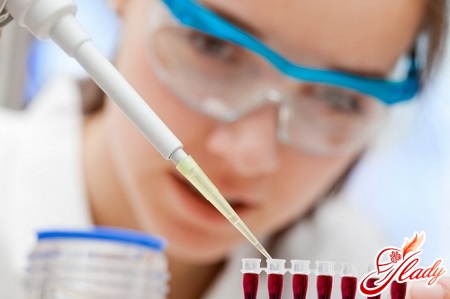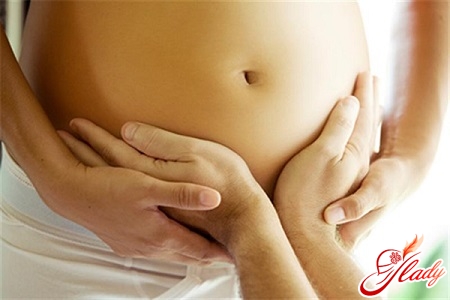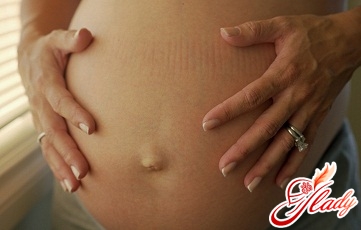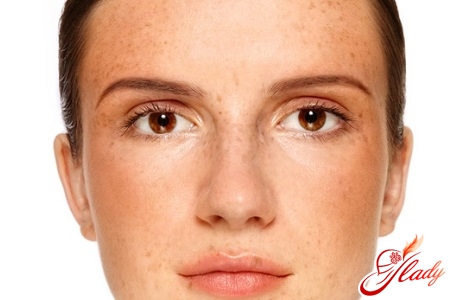
Pregnancy is a time of complex restructuringorganism of a woman. During this period, those hormonal failures, violations in the work of internal organs and other troubles occur, which are further exacerbated by poor environmental conditions, lack of vitamins, in particular, vitamin C, feelings for the future of the baby and stress. Under the influence of all these factors on the face of the future mother sometimes appear quite large pigment spots (or, as they are called, chloasma). They are also called the "mask of pregnant women". This pigmentation is often purely aesthetic problem, it is harmless for the health of both the pregnant woman and the baby. And this defect passes for several months after childbirth, but still the appearance of ugly spots on the face and body of a pregnant woman can and should be prevented.
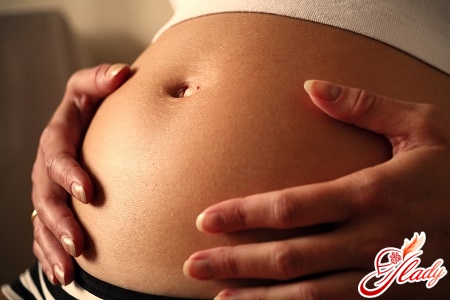
Why do the spots appear?
The skin of a woman's face (and not only duringpregnancy) has a very thin protective layer, as well as constantly experiencing an additional load from the applied makeup. In pregnancy, production of various hormones responsible for childbearing, in particular, adrenaline, sharply increases. At the same time, the production of hormones that are not related to the bearing of a child is significantly reduced. The acid-alkaline and water-salt balance of the body changes. The adrenal glands begin to work differently, as a result of which the blood of the adrenal cortex increases in the blood of the fair sex. Contrary to popular belief, male sex hormones have nothing to do with it. It produces less collagen, responsible for the elasticity of the skin. Because of deficiency of vitamins the face skin dehydrates and gets not absolutely healthy kind. Scientists do not yet have an unequivocal opinion about what is an indispensable condition for the appearance of pigmented spots. But among the main reasons are the following:
- Deep hormonal reorganization.
- Hereditary predisposition to the formation of pigment spots.
- Lack of vitamin C.
All this contributes to a more active developmentmelanin (from the Greek μελανος - "black") - a dark natural pigment contained in hair, skin, retina and other body tissues. He always manifests himself in similar situations of imbalance in the body, forming pigment spots on the skin. It is the production of melanin that causes the appearance of chloasma. The opinion that the formation of pigment spots is associated with metabolic disorders and excessive production of hormones is also confirmed by the fact of the appearance of chloasma in women with liver diseases (chronic and viral hepatitis, cirrhosis), genitalia (adnexitis, endometritis, etc.), and who use oral contraceptives.
How is pigmentation manifested during pregnancy?
Changes in the skin of the body in those prone to pigmentationwomen are already at the earliest stages of pregnancy. During the first two months, the okolosseous circles darken. By the end of the first trimester, the umbilicus may also darken, a flat or arched brown strip below it is formed, sometimes the skin color changes on the inner thighs, the nipples darken, new moles appear on the body, and freckles become brighter. Separately, it should be said about the pigmentation of the nipples. In nulliparous and nonpregnant women, the color of the nipples is pale pink. Pregnancy changes it to brown, and usually after childbirth, it remains the same for the rest of your life. Pigmentation of the face during pregnancy has the appearance of fairly large light brown spots on the cheekbones, around the mouth and nose, on the forehead. They, as a rule, disappear within 3-4 months after childbirth. The size of the chloasma is different. Sometimes their diameter does not exceed 1 cm in diameter, and sometimes one pigmented spot occupies the whole extensive area of the face. They are located more often on the forehead, upper lip, cheeks, nose bridge. Chin and eyelids are usually not stained. No unpleasant sensations (itching, soreness) the appearance of chloasma does not cause. However, they give the woman considerable psychological discomfort. 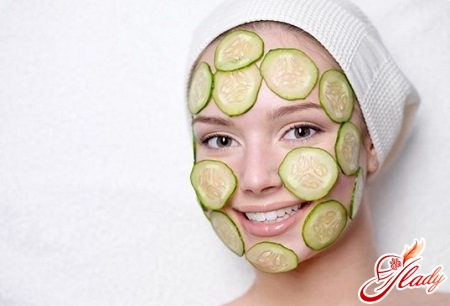
How to deal with age spots?
The first and most important condition is compliancethe correct diet, especially if there are deviations in the work of the liver, kidneys, spleen. In the menu must necessarily be present fruits and vegetables, dairy products, cereals, fish. Consumption of meat, as well as any heavy and fatty foods, should be minimized: it creates an additional burden on the liver and thereby provokes pigmentation. The same can be said about strong tea and coffee. It is best if during the pregnancy on the table there will be dishes cooked for a couple - this will facilitate their digestion. Do not abuse salt and sugar. Food should not cause allergies. It is necessary to take vitamins A, C, E, folic acid, helping to maintain the skin in good condition. They should enter the body of pregnant women not only as part of multivitamins, but also in the form of greens, cabbage, beets, carrots, spinach, oil, liver. Vitamin C is especially rich in broth of dogrose, apples, black currant, sauerkraut, citrus. The second mandatory requirement, which should be observed during pregnancy, are active walks in the fresh air. They help to normalize metabolism and accelerate the excretion of toxins from the body, prevent the appearance of pigment spots. Very useful gymnastics for pregnant women. It helps to improve blood flow and thereby maintains a good complexion. During motor activity, also collagen synthesis and cell division processes are accelerated, which can not but affect the skin condition in the best way. If nevertheless there was a pigmentation, it is necessary to apply natural humidifying and bleaching masks. For this, the same fruits and vegetables are good: strawberries, cucumber, grapefruit. Successfully fight pigmentation and mask based on kefir, sour cream or curdled milk. You can try proven "grandmother's" ways:
- apply a little kefir on the pigmented areas of the skin, hold for 15 minutes, and then rinse with water, preferably boiled;
- finely chop the fresh cucumber, apply on the pigment spots, rinse with cool water after 20 minutes;
- prepare a gruel from fresh parsley, leave on the face for about half an hour;
- ½ bell pepper grate, glassor plastic (only not on metal: metal contributes to the destruction of vitamin C, which is a lot in pepper and which is so necessary for pigmented skin). The resulting mass of a thick layer of paint on the pigment spots for half an hour. Wash off with cool water and grease the face with a nutritious cream;
- masks in the form of puree of fresh berries (mashed strawberries, strawberries, cranberries, red currants);
- mask of honey, melt water and purified pumpkin seeds, which must be applied to the pigment spots every day for about half an hour.
Of course, all these methods are suitable for those withwho does not have allergic reactions to the listed products. Whitening cosmetics industrial production at this time should not be abused, even if during pregnancy there is a strong pigmentation. Any salon cosmetic procedures for facial skin are also best performed only after consulting a doctor. You should refrain from sunburn, especially from a visit to the solarium. In general, the open sun should be less: an excessive amount of ultraviolet rays provokes the production of melanin. If exposure to the sun is still inevitable, then it is necessary to apply sunscreen with a high protective factor to the skin. The best modern means for protecting the skin of a pregnant woman from the sun is a cream with inorganic filters based on titanium dioxide and zinc oxide. These are harmless hypoallergenic substances that do not penetrate the skin and perfectly reflect ultraviolet rays. Such cosmetics should be used not only during pregnancy. Otherwise, there will be both pigmentation and wrinkles. It is necessary to avoid any contact of the skin with unknown or harmful chemicals that can provoke the development of pigmentation. Do not get involved in cosmetic procedures, especially with the use of synthetic cosmetic products, and even more so by unsafe procedures, such as chemical peeling. During pregnancy, it is generally better to stop using aggressive substances, otherwise pigmentation and other problems will not keep you waiting. Used cosmetics should be checked, quality and necessarily hypoallergenic. It is better if they are from the children's series. In medical and decorative cosmetics should not contain substances that increase sensitivity to ultraviolet radiation: oils of orange, bergamot, cinnamon, licorice, lavender, clover extract and St. John's wort. It is necessary to monitor the proper operation of the gastrointestinal tract, especially if there are chronic problems with the digestive system. The bowel should be emptied regularly, ideally - every day, the appearance of constipation is unacceptable. 
What if the chloasma does not disappear after giving birth?
In a number of cases, this really happens: pigmentation after pregnancy remains. The fact that pigment spots can "lie" at different depths of the skin. If melanocytes (cells in which melanin is produced) are found only in the surface layer (epidermis), then the chlorazma disappears fairly quickly and without outside help. If melanin penetrates both the epidermis and even the dermis (connective tissue under the epidermis), then it will be more difficult to combat pigmentation. In addition to the folk remedies mentioned, which must be continued to be used, the following treatment options are possible:
- Application of bleaching creams. However, during breastfeeding to bleaching creams should be treated with great care. Some of them may contain substances that penetrate into the mother's milk and are extremely harmful to the health of the baby, and the mother herself: arbutin, hydroquinone, bismuth salts and even mercury compounds. The cream can be applied to clean skin twice a day for 1-3 months. It acts selectively, whitening the pigmented areas, without affecting the surrounding skin.
- Procedures in beauty salons. Masters-cosmetologists bleach pigment spots with masks from salicylic acid and body-water; oxygen-stimulating procedures, in which the skin is saturated with oxygen and cleared of accumulated toxins; Deep cleaning with 20-60% glycolic acid, etc.
- To eliminate the already existing pigment spots andprevention of the appearance of new doctors can prescribe and medicines in the form of tablets or injections: ascorbic acid, calcium pantothenate, nicotinic acid, methionine, vitamin B2, - as well as whitening and exfoliating ointments.
- In the most serious cases, one can resort toabrasive removal of pigmented spots (gradual removal of the upper layer of the skin with jets of the smallest sand crumb) or to laser treatment - the so-called selective photothermolysis. In this procedure, ultrashort laser pulses are strictly selective, point to melanocytes - skin cells that produce melatonin, destroying them without harm to surrounding tissues. The pigmented spot is "burned" to the full depth, as a result of which melanin is removed from it and it is clarified.
However, this method of treatment has a number ofserious contraindications such as blood and hemopoietic diseases, AIDS and HIV, epilepsy, cancer, previous chemotherapy, acute infectious diseases, etc. Therefore, before starting treatment, you need to make a deliberate decision about the expediency of its conduct, of course, after consulting with a doctor.




